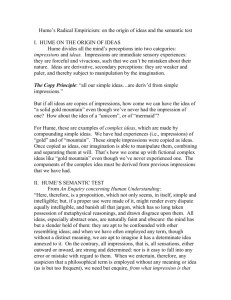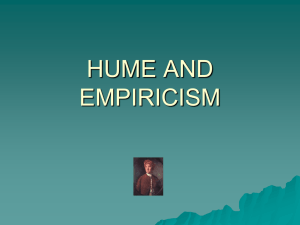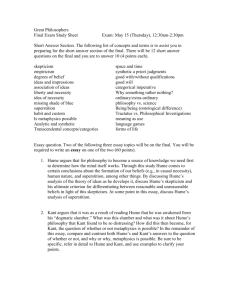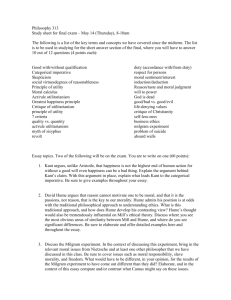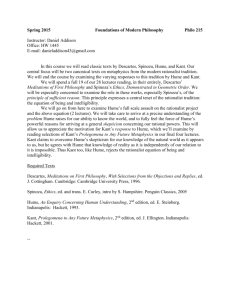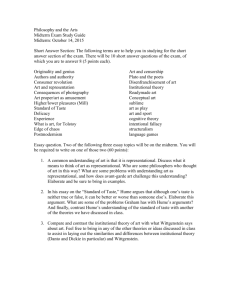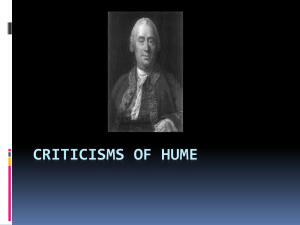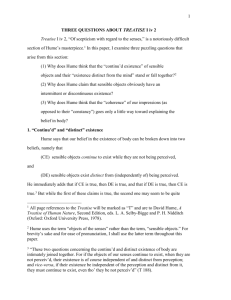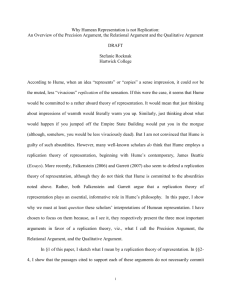Philosophical Readings commentaries
advertisement
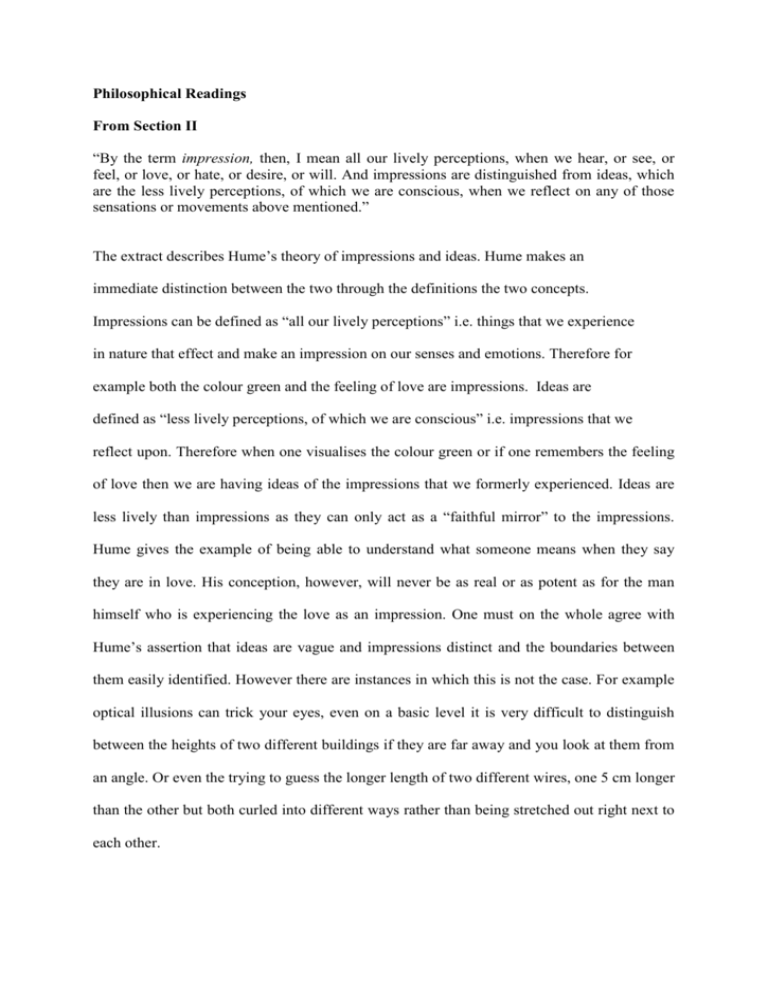
Philosophical Readings From Section II “By the term impression, then, I mean all our lively perceptions, when we hear, or see, or feel, or love, or hate, or desire, or will. And impressions are distinguished from ideas, which are the less lively perceptions, of which we are conscious, when we reflect on any of those sensations or movements above mentioned.” The extract describes Hume’s theory of impressions and ideas. Hume makes an immediate distinction between the two through the definitions the two concepts. Impressions can be defined as “all our lively perceptions” i.e. things that we experience in nature that effect and make an impression on our senses and emotions. Therefore for example both the colour green and the feeling of love are impressions. Ideas are defined as “less lively perceptions, of which we are conscious” i.e. impressions that we reflect upon. Therefore when one visualises the colour green or if one remembers the feeling of love then we are having ideas of the impressions that we formerly experienced. Ideas are less lively than impressions as they can only act as a “faithful mirror” to the impressions. Hume gives the example of being able to understand what someone means when they say they are in love. His conception, however, will never be as real or as potent as for the man himself who is experiencing the love as an impression. One must on the whole agree with Hume’s assertion that ideas are vague and impressions distinct and the boundaries between them easily identified. However there are instances in which this is not the case. For example optical illusions can trick your eyes, even on a basic level it is very difficult to distinguish between the heights of two different buildings if they are far away and you look at them from an angle. Or even the trying to guess the longer length of two different wires, one 5 cm longer than the other but both curled into different ways rather than being stretched out right next to each other. Hume furthers his explanation of his theory through explaining that none of our ideas can be formed without impressions. In order that confusion is avoided Hume addresses what people might see as a contradiction to this claim. He recognizes that we have ideas of things that we have not experienced. The most notable example of this is the idea of a “golden mountain”. Hume’s solution to this problem is that although we have never seen a gold mountain, the combination of our impressions of gold and of mountains can result in the idea of the gold mountain. Hume recognises that this idea is a simple one. Therefore he gives the example of our idea of God as “infinitely intelligent, wise, and good Being” comes from our own impressions of these qualities in ourselves. The more impressions used to form the idea, the more complex the idea. A challenge is presented to all those who doubts Hume’s theory to present an idea that could not have come first from an impression. He asserts that neither a blind man can have notion of colour nor a deaf man of sound. Perhaps Hume could have made this example better by getting us to imagine a blind man who had no contact with others who had experienced colour, but the theory remains in that the idea of colour could not exist without at least some one experiencing it. Hume himself provides one example of an idea not perceived directly from an impression to soothe the minds of those who cannot themselves think of one. He asserts that if a man were to be given a sheet with a spectrum of all the different shades of a colour, and there were blanks between some shades. That person could visualise what the shade would look like and conceive without too much doubt its existence without having actually seen it. The example is nevertheless a weak one due to the fact that we must still have had the impression of colour. Hume also remarks that this idea is so singular that it does not trouble the theory as a whole. What perhaps Hume does not consider is that if he, individually is able to think of a simple example contradicting his theory, is it not conceivable that there could be a far more complex example of this gap filling hypothesis. One could even distinctly unimpress him by suggesting that all of our many impressions could be amalgamated into an impression spectrum and that the gaps in between impressions could be impressions of God. This is a flawed example of course, but it does demonstrate that perhaps Hume, being merely one man could not have considered all possibilities. One could, however, counter argue by saying that since Hume there has not been presented such an example so it would strengthen his argument that his example is a singular case. From Section IV “We have said that all arguments concerning existence are founded on the relation of cause and effect; that our knowledge of that relation is derived entirely form experience; and that our experimental conclusions proceed upon the supposition that the future will be conformable to the past” In order to understand the passage fully, one must take the same steps that Hume himself takes in his reasoning. He begins the section with another distinction, in this case between Relations of Ideas and Matters of Fact. Relations of Ideas are ideas which are “intuitively or demonstratively certain.” Or more simply statements such as mathematical truths that prove themselves logically true. Hume explains that these types of ideas can be discovered by “the mere operation of thought, without dependence on what is anywhere existent in the universe.” These types of ideas cannot be denied without contradiction. Matters of Fact are ideas ascertained through experience; that it is raining outside right now, that I went dancing yesterday or that tomorrow the sun will rise are all matters of fact. They are all experienced a postierori and all can be denied through reason alone without contradiction. The only way to know if it is not raining is to check outside. Hume develops the theory of Matters of Fact further through explaining that we cannot know future matters of fact. The statement “the sun will rise tomorrow” is no more provable than saying that it will not. “Were it demonstratively false it would imply a contradiction and therefore could not be conceived by the mind”. Hume realises, however, that we do believe that the sun will rise tomorrow nevertheless. His explanation for why it is logical to have this belief is the idea of Cause and Effect. We hold the idea that the sun will rise tomorrow as it has risen every day of our lives previously. Hume proceeds to question how we could have the idea of Cause and Effect. He presents us with an analogy of billiards. If one were to hit one billiard ball into another we could not possibly know that the second billiard ball will move a priori. The statement that the ball will stay stuck is just as likely since it can be denied without contradiction. Therefore our knowledge of Cause and Effect must be discovered a postierori. Hume leads on into the question of how we can know that past experiences are adequate guides for predictions of future events. He explains that we cannot demonstratively show that future events will happen such as the sun will rise tomorrow, as we cannot look out of the window and see tomorrow. Therefore there is no contradiction in saying that the future will not be the same as in the past. Moral reasoning is just as unhelpful as the argument becomes circular. If we base our idea upon the principle that the future event will be the same as the past event, then we cannot know without assuming that the principle is correct without having experienced the future action. Hume accepts that he cannot prove the theory of causality due to his inability to prove or identify the principle which connects cause and effect together. However he asserts that the idea of cause and effect is so simple that even a child can understand it. A child knows that if he or she puts his or her hand in a fire then it will get burnt due to the fact that fire has always burned in the past. Therefore Hume identifies that the child learns the principle of cause and effect due to custom not reasoning.
